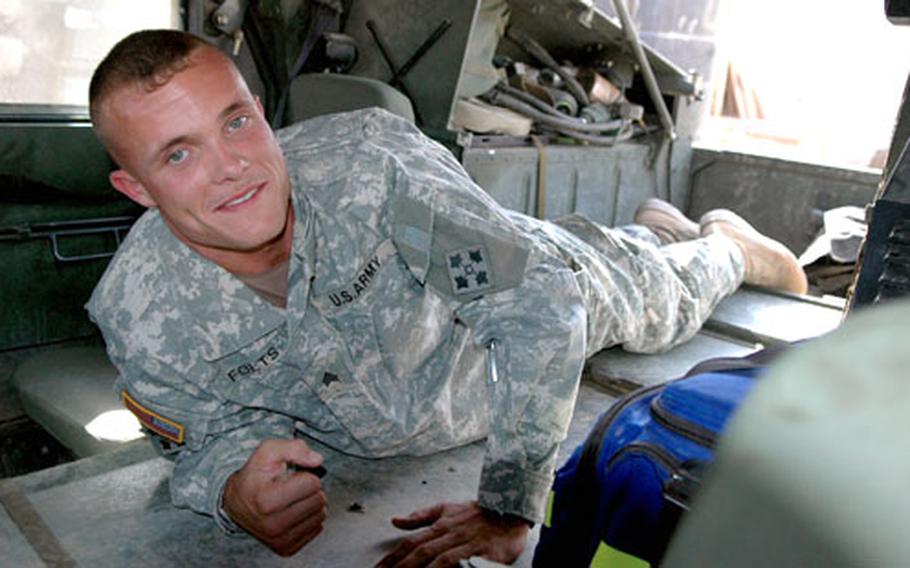
Sgt. Justin Folts, 23, stretches out in his modified Humvee. Folts, a medic with 3rd Battalion, 29th Field Artillery Regiment, part of the Fort Carson, Colo.-based 4th Infantry Division, came up with an idea to save lives by making room for wounded patients to lie down inside a Humvee. The back panel of the passenger cabin folds down to accommodate a stretcher. (Anita Powell / Stars and Stripes)
LOGISTICS SUPPORT AREA ANACONDA, Iraq — You’ve probably never met Sgt. Justin Folts. But someday, this 23-year-old’s simple innovation could save your life.
Folts, a medic with 3rd Battalion, 29th Field Artillery Regiment, 4th Infantry Division from Fort Carson, Colo., has come up with an idea to make room for wounded patients to lie down inside a Humvee.
The idea is simple: With a little bit of welding and less than $200 worth of parts, the back panel of the Humvee’s passenger cabin can be made to fold down (much like in a civilian car) making room for a stretcher to slide in lengthwise. Typically, patients suffer upright rides in the back seat — risking spinal injuries in the process — until they make it to a secure location for treatment.
The battalion has already modified 11 Humvees for this purpose; the 4th Infantry and 101st Airborne divisions are considering adopting the plan in the future as well.
“It keeps our promise to the soldiers to take care of them when they’re wounded,” Folts said of the idea, which he came up with over six months ago. “Without it, we keep our promise to take care of the wounded, but it’s not in as professional of a manner.”
But the idea wasn’t always so well-received. “It was rough at first,” he said. “I tied up with lots of people. I almost lost my rank. They said it wasn’t going to happen. They said no [Humvees] were being modified, and it would have to go all the way up the chain of command.
“Everybody else said, ‘Oh, just drop it,’” he recounted. “I said, ‘Until a general officer shoots this down, I’m going to keep knocking on doors.’”
Eventually, he found support from battalion commander Lt. Col. Jeff Vuono, who gave medics and maintenance personnel the go-ahead to look into the idea.
Spc. Ben Kissell, 26, was one of three welders involved in the design and execution. “We actually made the first design before any command issue was put out,” he said. “They were scared we’d get into trouble. In essence, we were destroying government property without the go-ahead.”
Battalion officials say the modification doesn’t hamper the safety of the vehicle. In fact, as part of the modification, welders attached extra blast plates to the panel, thus strengthening the panel. The first modified vehicle was sent outside the wire two months ago.
The modification “only takes 18 to 24 hours, depending on what condition [the vehicle is] in,” said Chief Warrant Officer 3 Joseph Bolte, maintenance control technician for the battalion. “In most cases, we have it out in a day and a half. It’s really inexpensive to do. Most of the stuff we use is already available to us.”
More important, he said, is the benefit to the wounded patient. “You can go from the ground into the truck in less than two minutes,” he said, adding that the battalion has yet to encounter a situation in which the modified vehicles were needed.
Having seen his idea go from pipe dream to fruition, Folts is surprisingly modest about his achievement.
“I don’t care who gets the credit, as long as it saves lives,” he said. “I don’t care as long as it helps somebody. I’m not going to make any more or less money. But … even if it’s only going to be used once, it’ll be worth it.”